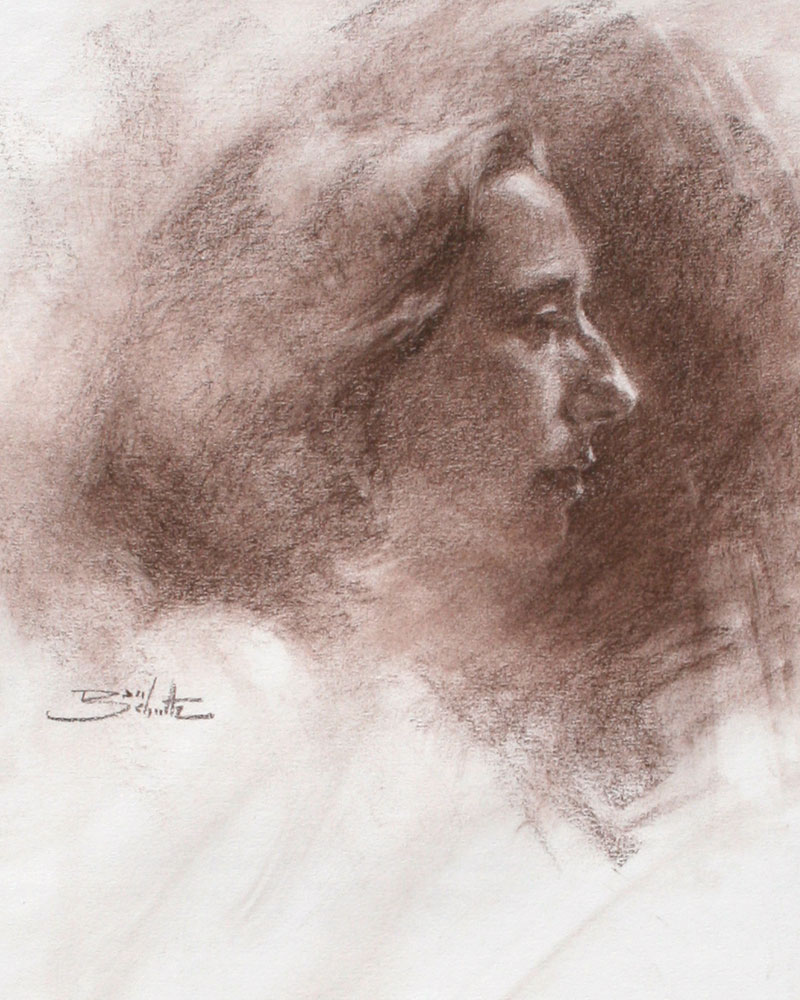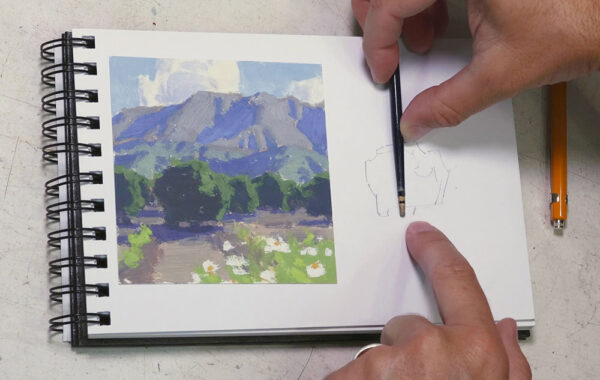Much of our effectiveness as artists begins with how we see. However, seeing accurately is difficult for most of us.
Have you ever struggled to draw something in proportion? Would you like to be able to paint a symmetrical vase in your still life? Perhaps you wish you could capture a portrait model’s likeness with ease. The good news is that by training our eyes, it’s possible to improve the way we see.
In order to train our eyes, we must first show them what is accurate. When I was learning to draw and was practicing portraits from life, I had a tendency to make certain mistakes repeatedly. One example: my portraits would always have too much distance between the nose and the mouth. In fact, I didn’t even recognize the error until a teacher pointed it out to me. My mind thought that distance in my drawing looked correct even though it wasn’t.
To fix my tendency, I had to measure closely to compare that distance to other distances on the model. Then I had to make sure I was carefully true to that comparison in order to draw accurately. As I put this into practice for several drawing sessions, the correct distance looked too small to me. But slowly, my eyes started to recognize the correct distance as being correct.
So how does one go about measuring? The idea is to compare two distances on the subject (often a horizontal distance compared to a vertical one), find a relationship between the two, then apply that same relationship to the drawing.
Imagine a portrait model for example. Let’s say that I discover that the horizontal width of the model’s head equals the same visual measurement as the vertical distance between the model’s chin and hairline. (I use a long-handled paintbrush to measure with, held at arms length.) Once I have made this comparison on the model, I make sure that the same relationship is true on my drawing (head width = distance from chin to hairline). If it isn’t, I adjust the drawing then double-check the measurement.
It’s helpful to remind yourself to measure extensively at first until it becomes a natural part of your process. And as your accuracy improves with practice, you’ll see how helpful measuring can be.
If you want to learn more, check out my video lessons at Sentient Academy and you can watch me demonstrate this measuring technique.


13 Responses
patti vincent
Your blog is great! Thank you so much for taking the time to share your art wisdom.
Dan Schultz
Thanks for reading, Patti!
judy
Hi Dan……the measuring technique works well enough when, for example, the relationship between the two lengths is 2:1, or 3:1, something easy like that. But let’s say the subject’s head is a “tiny bit of the paintbrush” wider than the vertical length…..how does one translate that to the measurement on the drawing……
thank you for this wonderful blog…..lots of terrific information.
Judy
Dan Schultz
Good question, Judy. In that instance, (if I can’t confidently eyeball it and simply allow the width of the head on my drawing to be a little greater than the vertical height) I usually try to find another way to measure the distance in question. For example, I might compare and find that the vertical distance from the chin to the eyebrows is half the distance of the overall head width. In other words, find another distance on the head that does allow an equal comparison. Does that make sense?
Laurie Schultz
Wow, love this blog too! Dan, these are the best tips, that can change our work, and make it exciting!
O.K… I also have a way to compare the details between the actual and drawn or painted picture. If I have a photograph of the person or scene, I find that, especially if you know the person, or you see the scene often, your brain is less accurate with the real details, and will fill in those details without really noticing the space or size relation when you try to paint or draw the picture. So, to MAKE your brain look at these details in a foreign way, I turn the picture and the drawing upside down. Then as you compare the two, the distances, and features in the face, become measurements. The real details are blatantly different than the ‘ face’ your brain knows. I’ve noticed bumps on noses, trees or limbs that appear on the actual tree, and not on my painting… and on and on.
I like the way you say to find a good place on the head to measure these things, if the measurement turns into ” A little bit past the nose or almost two noses wide.” Find a measurement that is accurate. Thank you, and what a beautiful new baby!!! Laurie
Luis Lopez
Dan,
Thank you very much sharing your experience and knowledge with us.
I am am afraid to do the human figure, with your tips I hope I will overcome that fear.
Luis
Dan Schultz
Thanks for the added suggestion to turn your drawing or painting upside-down for a different perspective, Laurie. That definitely makes one pay attention to each shape. I’m glad you’re enjoying my blog!
Dan Schultz
I’m glad to help if I can, Luis!
Valuable Studies in Value Dan Schultz Fine Art
[…] is a critical part of any successful representational painting or drawing. After design and drawing accuracy, it’s the next most important factor. No matter how strong in design, how impeccable in […]
Fabrice
I really dig your drawing, accurate and such atmosphere and character! Very nice!
What you tell is the truth and it’s so hard to come across a good website among all the easy to use methodes which reveale themselves wrong and limited.
Dan Schultz
Thanks for your nice compliments, Fabrice.
Guarantee Your Improvement
[…] 1. Drawing Accuracy Faithfully measuring greatly improves our drawing accuracy over time. Click here to read my previous post about measuring. […]
Joann M. Douk
I’m just reading your blog. Helpful tips with measurements. I’ve finally learned that it’s important to continue to check those measurements before it’s too late. Hence, one ear lower than the other, forehead and hairline either too small or too large.